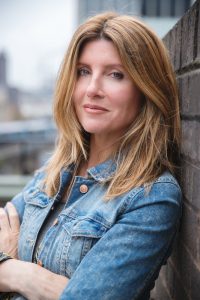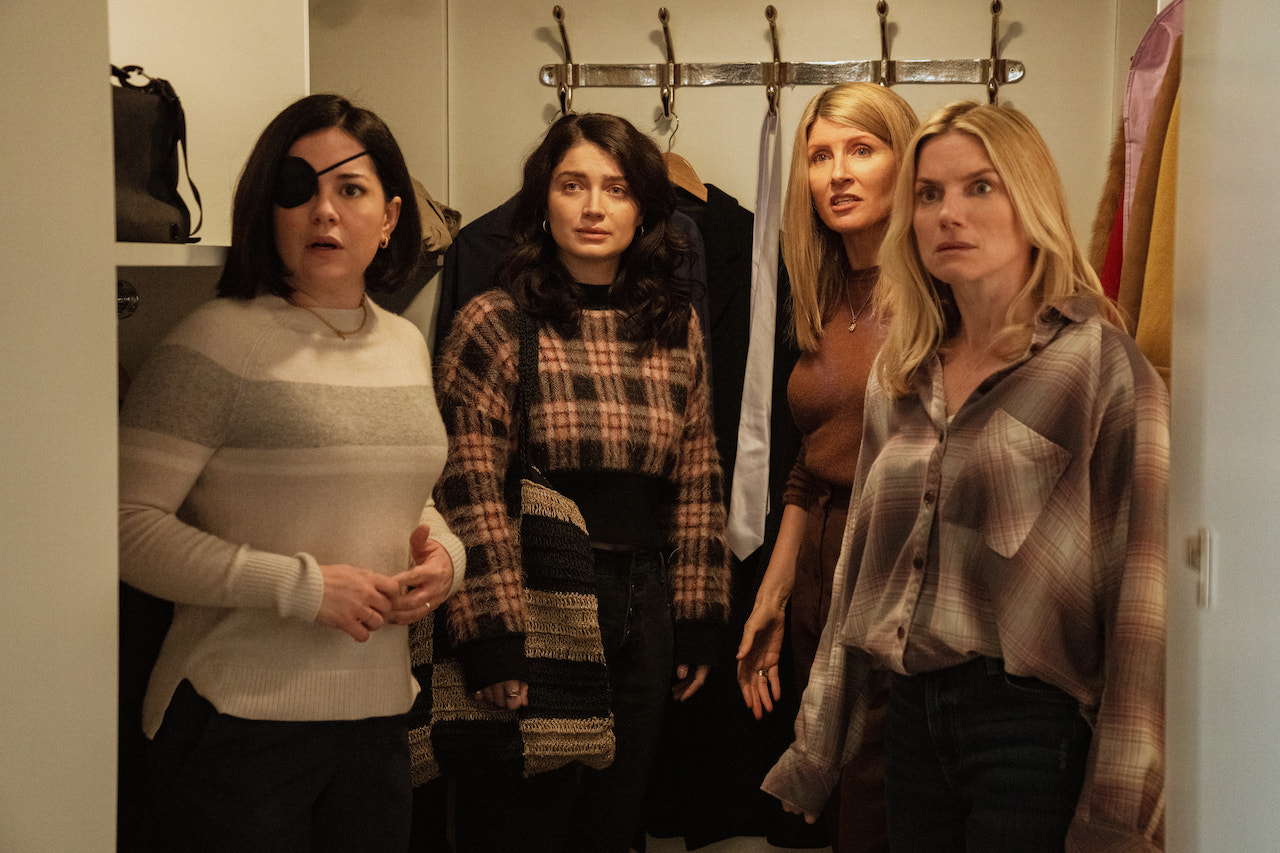This article contains mild spoilers.
Audiences can be assured of comedy that’s dark, gritty, and uproariously hilarious if it’s created by Sharon Horgan (Catastrophe, Shining Vale). Her latest offering Bad Sisters is no different – five sisters each with a motive to kill, a dead brother-in-law, and two “insurance detectives” determined to proved malicious intent form the backbone of Horgan’s comedy whodunnit.
Bad Sisters began its creative life as a Belgian/ Flemish TV series called Clan created by Malin-Sarah Gozin. Sharon Horgan put the Goethal sisters on a flight from Belgium to Ireland and changed their family name to Garvey along the way. Horgan spoke with Creative Screenwriting Magazine on getting this TV show made.
“What really spoke to me about the original was the idea of these five sisters, one of whom was married to a monster, plotted to kill him while being really bad at murder,” said Horgan. The comedy was generated in their constant trying and failing to kill him (John Paul “JP” Williams) while keeping their sisterhood at the center of their relationship.

Sharon Horgan
Bad Sisters isn’t all laughs and giggles. Horgan explores the ugly side of insidious domestic abuse. JP (Claes Bang) was married to Grace Garvey (Anne-Marie Duff) and was as much a victim as he was a perpetrator. He isolated Grace and accused her of undermining his worth to paper over his own shortcomings as a man and husband.
His abuse extended its tentacles to the other Garvey sisters Ursula (Eva Birthistle), Eva (Sharon Horgan), Bibi (Sarah Greene) and Becka (Eve Hewson). The Garvey sisters are often chalk and cheese, but are a fiercely loyal tribe nonetheless. They would kill for each other. And so, their next adventure of revenge begins.
Bad Sisters could have gone off the rails as five hapless sisters try their hand at being murders without having completed Murder 101.
“The most important thing to me was to ground the series in reality.” The original series contained an obligatory murder attempt in each madcap episode. “There was a hitman, a canning factory, and the Chinese mafia.” Horgan traded the great fun of the original for the darker aspects of domestic abuse in her version. The stakes were so high for these determined sisters, Horgan took this approach so “the audience would feel everything the sisters were going through, and to believe and root for them to win.”
Setting Bad Sisters in Ireland was a long-time dream for Sharon Horgan. Dublin’s legendary “Forty Foot” swimming area is a ritual for the locals, especially on Christmas Day. Everyone who dares takes a dip or a jump off the cliff no matter how cold the water. At the very least, it’s an effective tonic for hangovers.
“The story seemed to cry out for an Irish family. The sense of a small island and the outsider (JP) trying to become part of the Garvey island.” The Forty Foot Christmas Swim made it all come together for Horgan. Her TV series was born. “I had a lot of clarity after that. Forty Foot is a great place for a swim and to plan murders.”
A Special Brand Of Black Comedy
Sharon Horgan declines to set boundaries and label her brand of dark comedy. “We always dealt with hardcore material whether it’s alcoholism, mental health, or carrying a baby with Down’s Syndrome.” The comedienne basically inserted some of the most serious and unfunny life experiences into a comedy format. That’s dark, even unsettling. “If you can talk about these subjects, you can do something right in the show.” The template is simple. “You destroy people in one scene and lift them up in the next with laughter and joy.” Bad Sisters could never be straight up comedy or drama. Horgan relishes this gray genre hybrid her show exists in. In one scene JP is running around Ireland without any pants on and in the next a woman is being brutalized. Horgan is mindful of her intense brand of comedy, so she gave the audience some respite after an emotionally taxing scene.
Despite her ambitious type of comedy, Horgan always balanced a narrow tightrope to ensure the comedic balance was right. “Was there enough weight and emotional significance to a storyline or enough laughs in a scene?”

John Paul Williams (Claes Bang) Photo courtesy of Apple TV+
Sharon Horgan faced a uniquely comical dilemma with Bad Sisters. What genre is it? “Do we enter it as a comedy or drama for award consideration? We can’t do both.” After much deliberation, she decided it was a drama with moments of fun.
Meet The Garvey Sisters
The Garvey sisters made a pact to always look out for each other no matter what. “In some ways, the sisters are five different parallel versions of myself.” Horgan added that personally, she’s most like Eva and Becka from her rebellious younger years. “Becka had that paradoxical optimism while being battered.”
Horgan also wanted to examine the female experience and how JP impacted each of their lives. “It wouldn’t have worked in the same way if the Garveys were a mix of brothers and sisters or extended family.”
Eva is the eldest sister who’s sacrificed her own life to take on the parental responsibilities for her sisters. Ursula is the middle child with a husband, three kids and a cute little photography hobby. Bibi has created a stable home life with her wife Nora (Yasmine Akram) and their son Ruben (Jake Farmer), while Becka, the baby of the family is as reckless as she is directionless. All crave peace and stability in their lives through the JP experience, but none can fully achieve closure and resolution. “There’s an oestrogen-heavy witchiness to it.”
The pilot episode of Bad Sisters was arguably one of the most difficult to write because Horgan had to introduce five distinct personalities in a “succinct and economical way and hope the audience gets them immediately before she brings them together as a group. You need to care about them equally as individuals and their independent storylines.” When they all come together as a group they need to function as a “five-headed monster.”
The Garvey sisters navigated their lives without a sense of victimhood. They did what needs to be done despite their traumas and tragedies. “Losing their parents at an early age was almost fairytale-esque in terms of how they rely upon each other and carry themselves in the world after they leave home and form their own families.”
Orphanhood gave them a relationship with death
Bad Sisters had a tall mountain to climb with the characters of the Garvey Five. Giving them a cursory backstory of loss and a motive to kill may not have pulled the audience all the way in. “Each sister had their own selfish reason to want JP dead. It wasn’t just about saving Grace.” There were some spurious moral drivers.
JP had to be a worthy villain. “We had to make JP truly detestable with an arsenal of his acts.” If the audience bought into it initially, Sharon felt they would stay along for the entire season. “The audience loved hating him.”
One Show. Two Timelines
Bad Sisters unfolds in non-linear fashion – pre and post JP’s funeral. This narrative format was replicated from the original show Clan. “They [Clan] used dates and times to differentiate JP actions.” Bad Sisters used limited flashbacks to show JP transgressions. “We had to find a way for our characters to take us to the past at the right point. Equally, you need to find the right moment for the characters to leave the past and land back into the present.”

Thomas Claffin (Daryl McCormack) and Brian Gleeson (Thomas Gleeson) Photo courtesy of Apple TV+
This time-fragmented approach required a few attempts to get right. Horgan built the event timelines firstly in the writers’ room and again in the edit. “You had to be quite streamlined to transition between the time periods.”
Bad Sisters plays out more like a mystery thriller in some regards because we don’t initially know how JP died. It is only after the introduction of Thomas (Brian Gleeson) and Matthew (Daryl McCormack) Claffin detectives that audiences realize the sisters are suspects. As the series progresses, they discover that the Garveys unsuccessfully planned his murder. But did they succeed in the end given their history?
Sharon Horgan carefully crafted the relationships so they wouldn’t overshadow the murder with the slow infusion of clues into the narrative. “Investigations only work if we care about the people behind them.” The Claffin brothers had their own personal and financial issues to contend with in addition to a case of sleeping with the enemy. “It was Montague and Capulet high-level stakes to nail the final episode,” declared Horgan.
When we asked Horgan about what she writes about, she gleefully responded, “Our deepest, darkest thoughts and our nasty lives. If we weren’t honest about it, it won’t resonate with people.“
